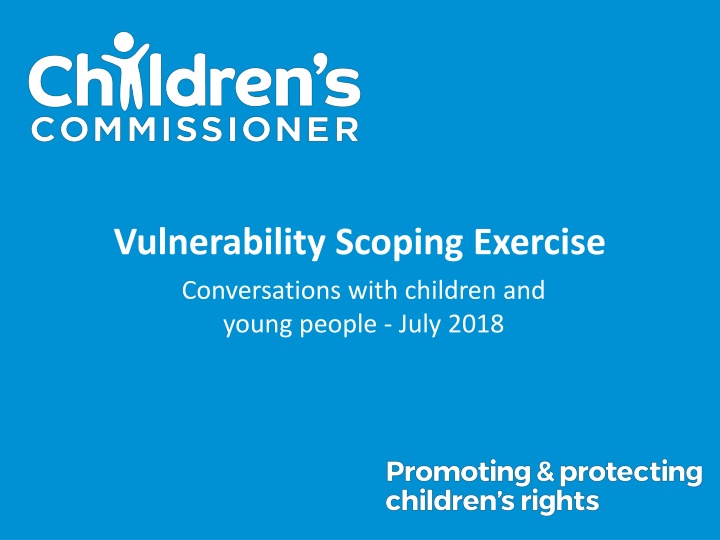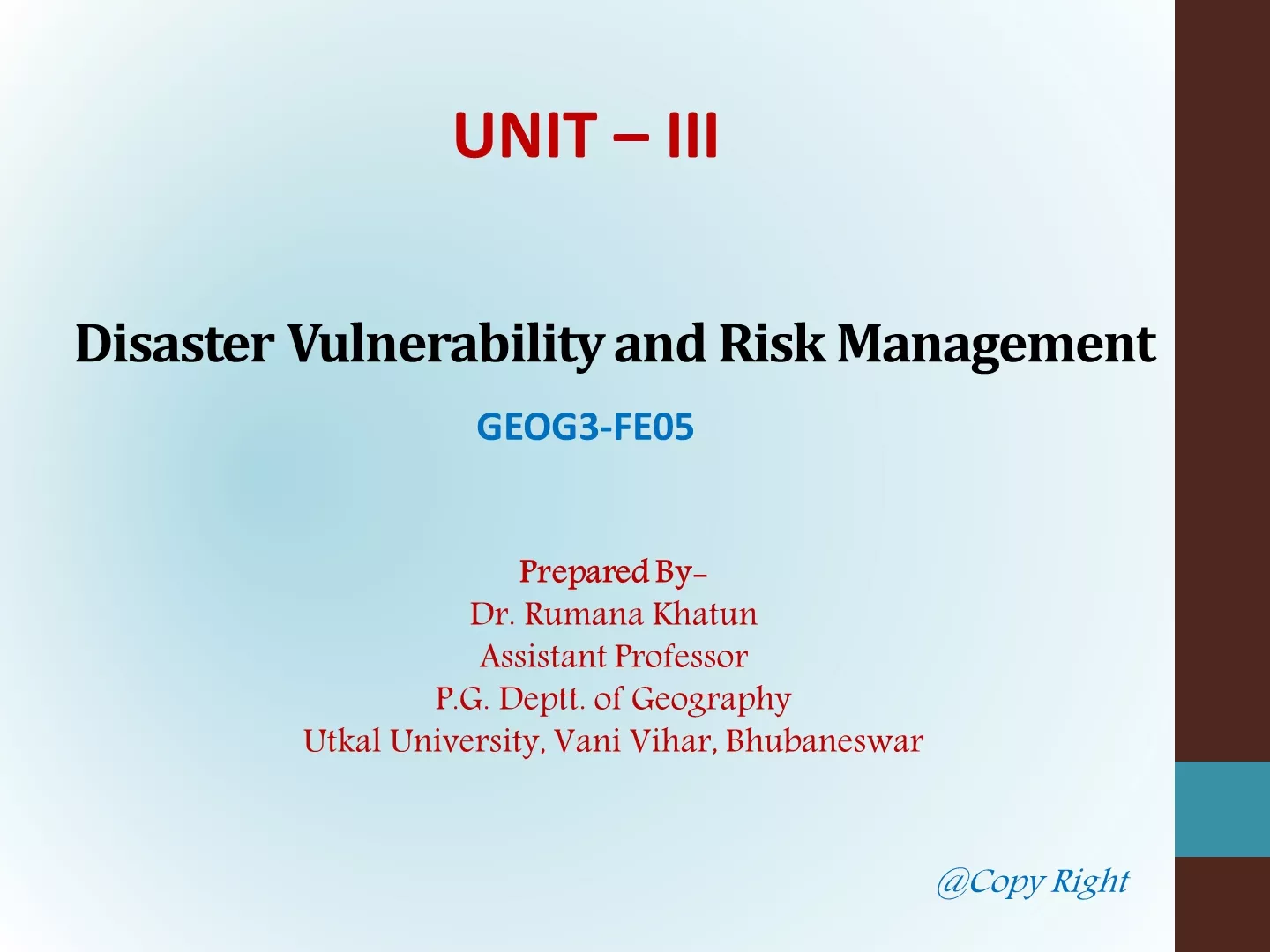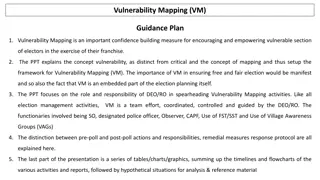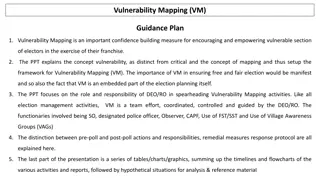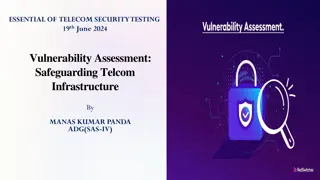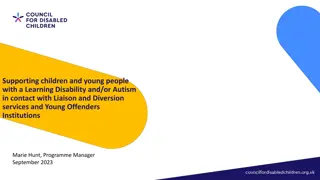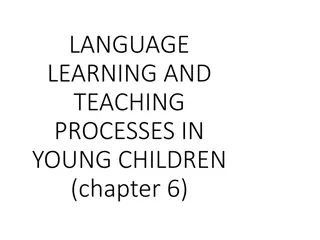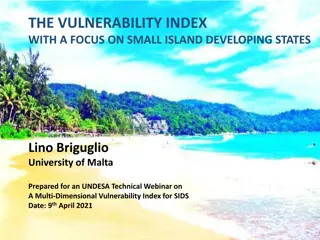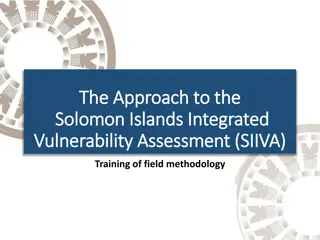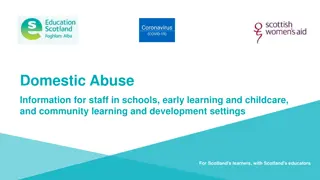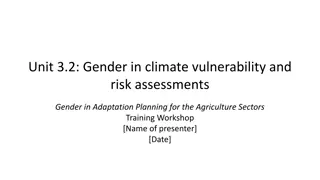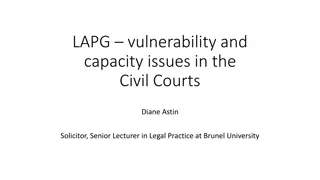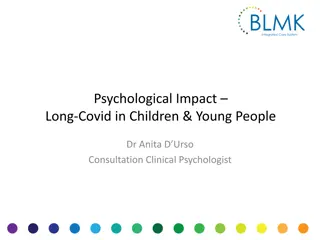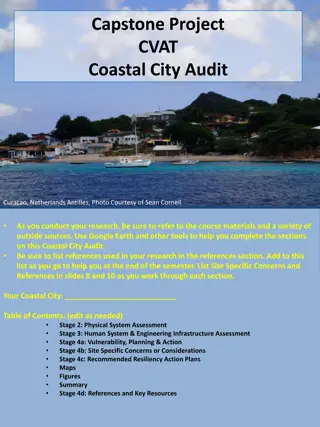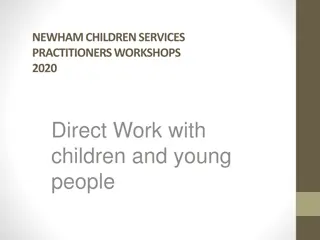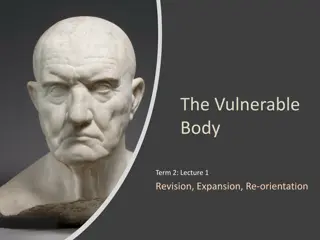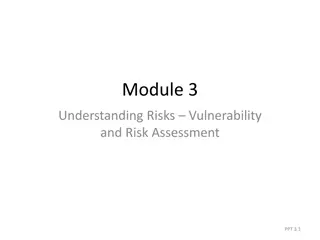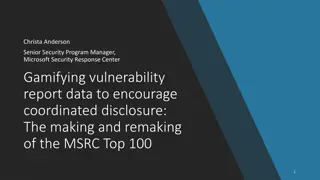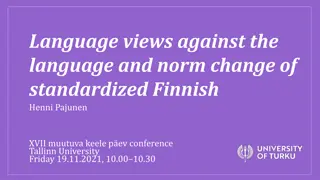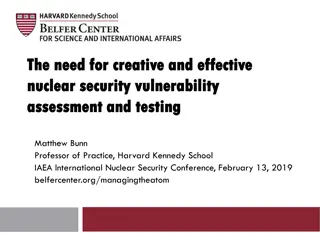Children and Young People's Views on Vulnerability and Language
Children and young people expressed their opinions on the language used to describe vulnerable groups, highlighting the negative impact of terms like "vulnerable." They emphasized the importance of language in defining and supporting individuals, advocating for more empowering and respectful terminology.
Download Presentation

Please find below an Image/Link to download the presentation.
The content on the website is provided AS IS for your information and personal use only. It may not be sold, licensed, or shared on other websites without obtaining consent from the author.If you encounter any issues during the download, it is possible that the publisher has removed the file from their server.
You are allowed to download the files provided on this website for personal or commercial use, subject to the condition that they are used lawfully. All files are the property of their respective owners.
The content on the website is provided AS IS for your information and personal use only. It may not be sold, licensed, or shared on other websites without obtaining consent from the author.
E N D
Presentation Transcript
Vulnerability Scoping Exercise Conversations with children and young people - July 2018
What the scoping exercise involved What the scoping exercise involved The Children s Commissioner wanted to begin a conversation with children and young people to gather their views on: The language used to talk about vulnerable children How information about children and young people is collected What they thought was important for the Children s Commissioner to consider for this vulnerability framework project We held focus groups with four existing participation groups that represented different groups in our framework Children and young people with special educational needs and disabilities (SEND) Children and young people that had been through the youth justice system Children and young people in a group focusing on emotional and mental health Children and young people who were or are looked after Age range of children and young people: 12-25
The importance of language The importance of language Children and young people we spoke with emphasised the importance of language when trying to define groups of children. It [language] is important. The semantics of everything you get into have to be crucially right, and I think the only people who can get that language right are the people it directly affects. I think language as a whole, is extremely, extremely important. Especially when you re trying to define everything, because if you get it wrong, then you re at risk of excluding people who genuinely need that support. Some of the children and young people belong to a group called the Waltham Forest Youth Independent Advisory Group. They shared with us a video the group had made called Victim blaming language which focused on the language used by professionals to describe victims of child sexual exploitation (https://youtu.be/0-R3FVCEN8I). The video emphasised the importance of the language professionals use to describe vulnerable children and young people. Some of their key messages are quoted below and resonate with many of the views that children and young people shared with us during this scoping project. The language you use matters it affects how people see us it makes us feel like what s been done to us is our fault and it makes us feel less of a person. Negative language reinforces negative attitudes and negative attitudes leads to systematic failures to protect us. Helping us starts with the language you use, so choose it carefully.
What children and young people said about the What children and young people said about the term vulnerable term vulnerable They do not like the term vulnerable and some find it offensive. The term carries very negative connotations which in turn reinforces negative stereotypes about children and young people identified as belonging to one of these groups. Consequently children and young people do not want to be labelled as vulnerable . It is a disempowering term that suggests a lack of agency, independence or control. [The term vulnerable] may be misunderstood by some who will relate it to more about being weak than needing more support, will see it as just being referred to as helpless. It is a patronising term often used by professionals which many children and young people cannot relate to. [The term vulnerable] felt patronising. Like I couldn t look after myself, so someone else had too like something was going to happen and I could not maintain my safety. People don t use [vulnerable] to describe themselves. The word vulnerable fails to capture the resourcefulness and resilience of many children and young people identified as belonging to these groups. The term vulnerable places responsibility on the individual rather than on external factors and can impact on a child or young person s self worth and on the choices they make. When a professional first steps into a young person s life they will start saying this [you are vulnerable] to the child no matter what so I grew up being called vulnerable even though at some points I actually wasn t I was still thinking ok I m vulnerable so I might as well go out there and do this vulnerable stuff straight from a very young age your called vulnerable as you grow up it does not help in any kind of way.
The impact of being called vulnerable The impact of being called vulnerable The negative connotations of the term vulnerable can lead some children and young people to feel like they have to hide or not talk about the difficulties they face. [In prison] When the word vulnerable is used it means you are not with us it means you are over here with people who cannot handle prison - who are doing things to themselves that we would probably frown upon instantly, you would be classed as weak you re finished. The term can make children and young people feel weak, fragile, invisible, and helpless. It reinforces the idea that they cannot cope or do anything for themselves. It can also make children and young people feel like something bad is going to happen to them. It makes me feel like the fairy-tale maiden in the tower who needs others to do things for her. People make me feel like I can t do something. I wouldn t like it [being called vulnerable] personally. Sounds kind of like you re weak. I ve been vulnerable before and I ve felt that I ve, like, lost independence. Like everyone kept saying vulnerable like something was going to happen to me. The word vulnerable makes children and young people feel different and separate from others. They saw this as supporting a culture where they are often not treated as equals. Some also argued that everyone is vulnerable in one way or another, but that the term is used in a way that segregates certain groups.
What children and young people said we could do What children and young people said we could do Some did acknowledge the need for a blanket term for children and young people who may need support from government agencies. They also recognised that inevitably any term may end up having negative connotations. Vulnerable works as an umbrella term, whether in social services or in the education system, it helps to classify in a broader way that these are children that need extra support or some kind of intervention. They thought this could be mitigated by providing clear explanations in any report about how that word is being used in that particular context. If terms like vulnerable needs to be used, the preference was for the term to be used to describe a group, and never an individual within that group. Having the blanket term [like vulnerable] is perhaps one of those necessary evils. It s ok if you can distinguish between being called vulnerable as part of a group and as an individual. - but it should not lead to getting in the way of tailored response to different needs. Some children and young people preferred the term being at risk because this better identifies the external and contextual factors that can create problems for children and young people. The term better denotes societal failures rather than failures in the individual. When you say vulnerable groups get offended, because you re patronizing them, whereas at risk could empower them, you can take power in that label and still recognise you re at risk it s like saying that there is nothing that is disadvantaged about you but it could be a reason you are at risk because you can t access certain opportunities so I think that s where that language is important. Because I think that if we look at people s identities, which really matter to people s humanity, then they don t like that whole aspect of their identity being described as an issue but they kind of accept that it does make them at risk of certain things or excluded from certain situations.
What children and young people said about the language What children and young people said about the language used to describe certain vulnerable groups used to describe certain vulnerable groups Some key examples of discussions about the language used to described certain vulnerable groups are given below: Sexual and gender minority children and young people: The term sexual and gender minority was not seen as appropriate. Using the word sexual makes children sound promiscuous, and using the word minority can be offensive to some. The group should be included in the vulnerability framework but the group should be labelled LGBTQ+ children. I would include that group as being vulnerable, I myself identify within that group and can feel vulnerable in certain situations, however I would call them LGBTQ+ children, because that is exactly what they are. Children and young people in care: Children and young people did not like the term children in care . They preferred the term looked after because it directly describes the action of being taken care of, rather than a descriptive label (which often carries negative connotations). Children and young people also felt the term looked after made it sound like those who were now looking after them cared about them. It[looked after] sounds more like the people who look after us care.
What children and young people said about the language What children and young people said about the language used to describe certain vulnerable groups used to describe certain vulnerable groups Disabled children and young people: Language around disability is seen as particularly negative and children and young people spoke about how it made them feel inferior, frustrated and depressed. You just want to die - you don t feel like you are right for society - you think why am I in this world - you feel worthless. I m just human and I don t want to have the label of disabled. The word disabled starts with dis which perpetuates the negative stereotype that disabled children and young people are not able to do things rather than that they are able to do things in other ways with different types of support. The actual word disabled - has dis in front of it - it kind of states that you re not able to do things - rather than actually realising that you re not actually disabled - you are just able at other things in different ways -or you just need extra support to do those things - we can do it - just not in the same way as other people and in the right conditions.
What children and young people said about the language What children and young people said about the language used to describe certain vulnerable groups used to describe certain vulnerable groups Children and young people and mental health: The terminology around mental health is not accessible and children and young people may find it hard to relate to the words often used. This can be a barrier to children and young people talking about their mental health. Victim blaming language is common and can come across as very judgemental. It makes children and young people feel like their problems are their own fault and that there is something wrong with them. The language around self-harm was identified as being particularly problematic. The negative words and phrases makes it sound like you have something wrong with you. Children and young people suggested that the term mental health be changed to emotional health and wellbeing.
What children and young people said about the What children and young people said about the interactions between vulnerabilities interactions between vulnerabilities There was a clear understanding that any child or young person might have multiple vulnerabilities and that often there was a risk when being assessed by professionals that one vulnerability might be identified while others might be ignored and consequently not addressed. Children and young people spoke about how being in one group can put you at risk of being in another group. Some key groups identified include children and young people: who have been abused who have SEND with emotional health and wellbeing issues in care living in poverty Being in one group will put you at higher risk of being in another - it s a domino effect - you get physical health issues, then mental health from that, then you get bullied, then you go into a gang for protection - and round and round like that - one knocks you into another.
Key factors associated with negative experiences Key factors associated with negative experiences of having their information collected of having their information collected Children and young people were asked about their own experiences of having their information collected. Some key factors associated with their negative experiences are listed below. When professionals don t listen to what children and young people have to say about their own experiences, asking parents or carers to speak on their behalf instead. Found that professionals [CAMHS] asked my mum how I was feeling rather than me and they took her account a lot more into perspective than mine and that ended up with an extremely late diagnosis. So maybe if professionals started listening to young children - the thing is they never asked me on my own till I was about 16 all the time they said bring your mum with you. Using inaccessible language, full of jargon, that children and young people do not understand. [In prison] when you sit there and say things to me, I d be what s that? , we re all looking at each other saying shit we ain t got a clue - so that s important, terminology is massive. Being asked the same questions repeatedly by different professionals because professionals fail to communicate with one another or to read the files they may already have access to.
Key factors associated with negative experiences of Key factors associated with negative experiences of having their information collected having their information collected Not being told why the information is being collected and how it is going to be used. This can lead to anxieties about what will be done with the information and who it will be shared with. When information that is collected is manipulated by professionals to meet their own needs not the needs of that child or young person and can often feel like a tick box exercise. SENCO's not as good as teachers - when SENCO did it [collected my information] - was quite distant and formal - my teachers wrote down what I said, but the SENCO wrote down what the form needed it to say rather than actually realising that s not actually what I meant. When information being collected is not actually used properly to help the child or young person. When you go to prison do you know what the first thing they ask you in your induction week? What do you want to be, how do you want to do it so they can give you a sentence plan, - by the time you end up [back in the community] you re not going into college so all this information you ve collected about me - about what I want to do and who I want to be you are not using it properly.
What children and young people said about how What children and young people said about how data collection practices can be improved data collection practices can be improved Children and young people gave us recommendations for how data collected practices could be improved: Provide children and young people with transparent and accessible information about why that data is being collected and how it might benefit them. Where possible, provide feedback about how the information has been used. There needs to be something for children that is child friendly that you don t have to do any training to understand - stating we are collecting information for x,y and z this will be used for x,y and z and we ll come back to you as well it s always good to let people know come back and let us know how results helped I suppose. Collect information in person, face-to-face, rather than over the phone or via correspondence. Maintain eye contact and try and be understanding and compassionate and not robotic and impersonal. Collect information from children and young people who are never heard. Have familiar teachers (or other adults that children and young people know well) collect the information on behalf of other agencies/ organisations. This would be a more comfortable experience for children and young people. Give children the right to have their information deleted if they so wish from any databases where their information might be held.
What children and young people said about What children and young people said about the CCO vulnerability the CCO vulnerability f framework They understood the need to estimate the number of vulnerable children and young people within all the identified vulnerable groups. ramework Project Project They emphasised the need to ensure this is done carefully and alongside consulting children and young people about the list of vulnerability groups. Furthermore, any outputs should be child friendly. Vulnerability is subjective to different people. Official bodies may not see some people as vulnerable, but if you ask the person they might see themselves as vulnerable. You could do qualitative research about their ideas of vulnerability. Some professionals might see some people as vulnerable but they might not see themselves as vulnerable. They noted that placing groups that no children should be in together with groups that children should feel proud to be in, all under one framework, could risk unfairly painting certain groups in a negative light. I think my problem with this list is that, like some of the stuff is clearly negative, whereas like, some of the stuff isn t. So when all of them are grouped together as part of a vicious cycle, it paints them all in a negative light. It is important not to just report on the numbers but to also include the voices of children and young people identified as belonging to these groups. Children and young people want to feel like they are being represented as real people with real stories, not just another number or statistic. I would personally do one thing I would find a person in every single one of those spheres, so bring in an ex-gang member, with poverty get that person whose mum s is in the food bank, get a disabled young person, follow them on that journey you are still going to come out with numbers but you may also come out with an underlying social justice story. Don t just go around the country collecting numbers it doesn t say much about the people Quantifying it all into numbers doesn t give an accurate presentation of anything, because my experiences are totally different to every other care leaver... The numbers give you nothing because we are not an average.
What will do with this information? What will do with this information? We have taken this feedback into account as we continue to develop the vulnerability framework. We will consider how this feedback relates to other projects we are working on. We will continue to carry out more direct research with children and young people, working with third sector and other partners, to ensure their voices are heard and inform our understanding of their experiences. We want the vulnerability framework to be used as a structured mechanism through which to ensure the voices of children and young people are heard in a representative way. The framework will not just be a way to capture the numbers but to also map out where existing research that captures the voices of children and young people exists, and where there are key gaps that need addressing. I know you can t ask them all (all children and young people) but it might be good to have some personal stories in your reports. If you have any questions about this work please contact Ellie Mendez Sayer on Ellie.Mendez- Sayer@childrenscommissioner.gsi.gov.uk
